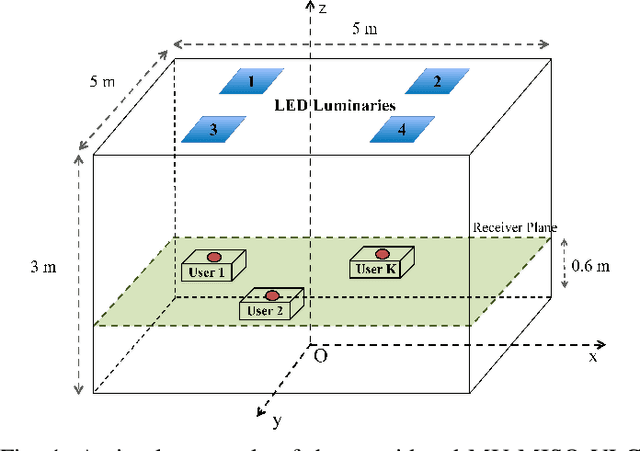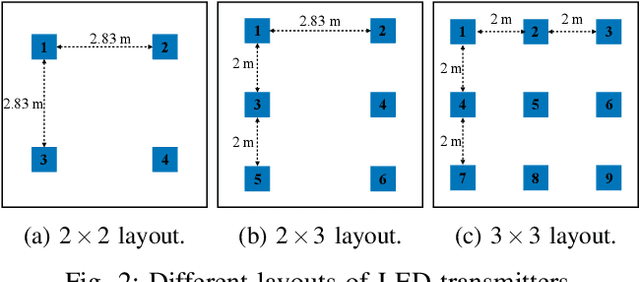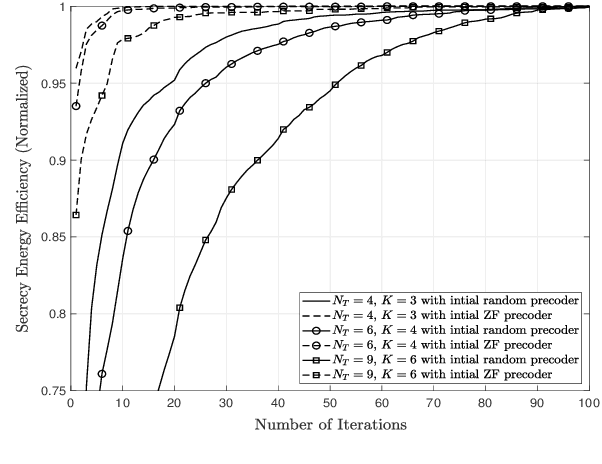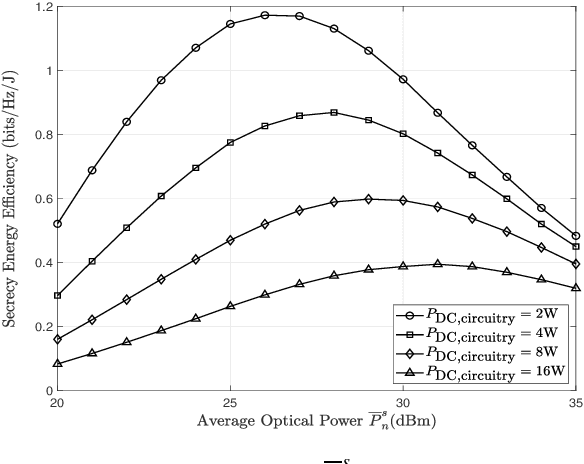Thanh V. Pham
Optimization of Probabilistic Constellation Shaping for Optical OFDM Systems with Clipping Distortion
Jul 10, 2025Abstract:Optical orthogonal frequency-division multiplexing (OFDM) and probabilistic constellation shaping (PCS) have emerged as powerful techniques to enhance the performance of optical wireless communications (OWC) systems. While PCS improves spectral efficiency and adaptability, we show that its integration with optical OFDM can inadvertently increase the peak-to-average power ratio (PAPR) of the signal, exacerbating clipping distortion due to signal clipping. This letter investigates the impact of PCS on the PAPR of direct current-biased optical OFDM (DCO-OFDM) waveforms and proposes an optimization of PCS that maximizes channel capacity, considering clipping distortion. The optimization problem is shown to be complex and non-convex. We thus present a suboptimal yet efficient solving approach based on projected gradient descent to solve the problem. Simulation results demonstrate the superiority of the proposed approach over the conventional uniform signaling, particularly under severe clipping distortion conditions.
Secrecy Capacity of Hybrid VLC-RF Systems with Light Energy Harvesting
May 19, 2025Abstract:This paper studies the performance of physical layer security (PLS) in a multi-user hybrid heterogeneous visible light communication (VLC) and radio frequency (RF) wireless communication system with simultaneous lightwave information and power transfer (SLIPT). In the considered system, VLC is used for downlink (DL) while RF is employed for uplink (UL) transmission. In addition, to support multiple users, time division multiple access (TDMA) is assumed for both DL and UL channels. In the DL, each user receives information during its allocated time slot of the TDMA frame and harvests energy from the received signal outside the time slot. The harvested energy is then used for transmitting the signal over the UL channel, which is subject to eavesdropping by an unauthorized user. Therefore, PLS is employed to protect the confidentiality of the UL information. Then, an optimization problem is formulated to solve the optimal DL and UL time slots that maximize the PLS performance given a target sum rate of the DL. We show that the problem can be cast as a difference of convex functions (DC) program, which can be solved efficiently using the DC algorithm (DCA).
High Performance Signal Design for ACO-OFDM Systems using Variational Autoencoder
May 12, 2025Abstract:This letter proposes a design of low peak-to-average power ratio (PAPR), low symbol error rate (SER), and high data rate signal for asymmetrically clipped optical orthogonal frequency division multiplexing (ACO-OFDM) systems. The proposed design leverages a variational autoencoder (VAE) incorporating gradual loss learning to jointly optimize the geometry and probability of the constellation's symbols. This not only enhances mutual information (MI) but also effectively reduces the PAPR while maintaining a low SER for reliable transmission. We evaluate the performance of the proposed VAE-based design by comparing the MI, SER, and PAPR against existing techniques. Simulation results demonstrate that the proposed method achieves a considerably lower PAPR while maintaining superior SER and MI performance for a wide range of SNRs.
Secrecy Performance Analysis of Space-to-Ground Optical Satellite Communications
Feb 21, 2024



Abstract:Free-space optics (FSO)-based satellite communication systems have recently received considerable attention due to their enhanced capacity compared to their radio frequency (RF) counterparts. This paper analyzes the performance of physical layer security of space-to-ground intensity modulation/direct detection FSO satellite links under the effect of atmospheric loss, misalignment, cloud attenuation, and atmospheric turbulence-induced fading. Specifically, a wiretap channel consisting of a legitimate transmitter Alice (i.e., the satellite), a legitimate user Bob, and an eavesdropper Eve over turbulence channels modeled by the Fisher-Snedecor $\mathcal{F}$ distribution is considered. The secrecy performance in terms of the average secrecy capacity, secrecy outage probability, and strictly positive secrecy capacity are derived in closed-form. Simulation results reveal significant impacts of satellite altitude, zenith angle, and turbulence strength on the secrecy performance.
Energy-Efficient Precoding for Multi-User Visible Light Communication with Confidential Messages
Feb 22, 2021



Abstract:In this paper, an energy-efficient precoding scheme is designed for multi-user visible light communication (VLC) systems in the context of physical layer security, where users' messages are kept mutually confidential. The design problem is shown to be non-convex fractional programming, therefore Dinkelbach algorithm and convex-concave procedure (CCCP) based on the first-order Taylor approximation are utilized to tackle the problem. Numerical results are performed to show the convergence behaviors and the performance of the proposed solution for different parameter settings.
 Add to Chrome
Add to Chrome Add to Firefox
Add to Firefox Add to Edge
Add to Edge